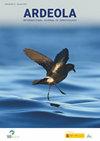Monitoring Abundance and Distribution of Northern Gannets Morus bassanus in Western Iberian Waters in Autumn by Aerial Surveys
IF 1.2
4区 生物学
Q2 ORNITHOLOGY
引用次数: 2
Abstract
Summary. Several North Atlantic breeding seabirds, such as the Northern Gannet Morus bassanus, use Western Iberian Waters for wintering and migration. In this study, we aimed at producing absolute population estimates of post-breeding Gannets and evaluating the importance of the study area within the species' migration range. We performed six aerial surveys in September and/or October each year between 2010 and 2015, covering 74,840 km2 in total. Using line transect methodology, 3,672 Gannet sightings were recorded along 10,496.3 nautical miles (nm). Immature individuals and adults comprised approximately 87% of all sightings. Using Distance sampling, overall abundance was estimated at 89,930 birds, ranging from 58,010 individuals in 2014 to 128,140 in 2015. The highest densities per sector areas were recorded in the North and Centre sectors whereas the lowest densities were registered in the Galicia sector, the Spanish region within the study area. Gannets were mostly present in shallow shelf waters of the continental shelf, particularly between 3 and 20 nautical miles offshore. Habitat suitability models for Gannets in the study area were tested using several eco-geographical variables and chlorophyll concentrations were found to contribute most to explaining annual Gannet occurrence probabilities. A global interannual spatial analysis demonstrated the core areas for conservation of the Northern Gannet in Western Iberian Waters. Moreover, our results demonstrate that Western Iberian waters are used by almost 10% of the global Northern Gannet population, corroborating the existence of seabird hotspots during the non-breeding period, along migration corridors and at their wintering grounds.—Araújo, H., Correia Rodrigues, P., Bastos-Santos, J., Ferreira, M., Pereira, A., Martínez-Cedeira, J., Vingada, J. & Eira, C. (2022). Monitoring abundance and distribution of Northern Gannets Morus bassanus in Western Iberian Waters in autumn by aerial surveys. Ardeola, 69: 179-202.秋季伊比利亚西部水域北部塘鹅Morus bassanus数量及分布的航空调查
总结。一些北大西洋的繁殖海鸟,如北方塘鹅,使用西伊比利亚水域越冬和迁徙。在本研究中,我们旨在产生繁殖后塘鹅的绝对种群估计,并评估研究区域在物种迁移范围内的重要性。在2010 - 2015年期间,我们每年9月和/或10月进行了6次航空调查,总覆盖面积为74,840平方公里。采用样线法,沿10,496.3海里(nm)记录了3,672例塘鹅目击事件。未成熟个体和成年个体约占所有目击事件的87%。使用距离采样,总体丰度估计为89,930只,从2014年的58,010只到2015年的128,140只不等。每个扇区的最高密度记录在北部和中部扇区,而最低密度记录在加利西亚扇区,即研究区内的西班牙地区。塘鹅主要分布在大陆架的浅水中,特别是离岸3至20海里之间。利用多个生态地理变量对研究区塘鹅生境适宜性模型进行了测试,发现叶绿素浓度对解释塘鹅年发生概率贡献最大。一项全球年际空间分析显示了西伊比利亚水域北部塘鹅保护的核心区域。此外,我们的研究结果表明,全球近10%的北方塘鹅种群使用西伊比利亚水域,这证实了在非繁殖期,沿迁徙走廊和越冬地存在海鸟热点。-Araújo, H., Correia Rodrigues, P., Bastos-Santos, J., Ferreira, M., Pereira, A., Martínez-Cedeira, J., Vingada, J. & Eira, C.(2022)。通过空中调查监测秋季西部伊比利亚水域北部塘鹅的丰度和分布。中国生物医学工程学报,29(6):779 - 782。
本文章由计算机程序翻译,如有差异,请以英文原文为准。
求助全文
约1分钟内获得全文
求助全文
来源期刊
CiteScore
2.30
自引率
6.20%
发文量
16
审稿时长
>12 weeks
期刊介绍:
Ardeola: International Journal of Ornithology is the scientific journal of SEO/BirdLife, the Spanish Ornithological Society. The journal had a regional focus when it was first published, in 1954. Since then, and particular during the past two decades, the journal has expanded its thematic and geographical scope. It is now a fully international forum for research on all aspects of ornithology. We thus welcome studies within the fields of basic biology, ecology, behaviour, conservation and biogeography, especially those arising from hypothesis-based research. Although we have a long publication history of Mediterranean and Neotropical studies, we accept papers on investigations worldwide.
Each volume of Ardeola has two parts, published annually in January and July. The main body of each issue comprises full-length original articles (Papersand Review articles) and shorter notes on methodology or stimulating findings (Short Communications). The publication language is English, with summaries, figure legends and table captions also in Spanish. Ardeolaalso publishes critical Book Reviewsand PhD-Dissertation Summaries; summarising ornithological theses defended in Spain. Finally there are two Spanish-language sections, Ornithological News; summarising significant recent observations of birds in Spain, and Observations of Rare Birds in Spain, the annual reports of the Spanish Rarities Committee.

 求助内容:
求助内容: 应助结果提醒方式:
应助结果提醒方式:


